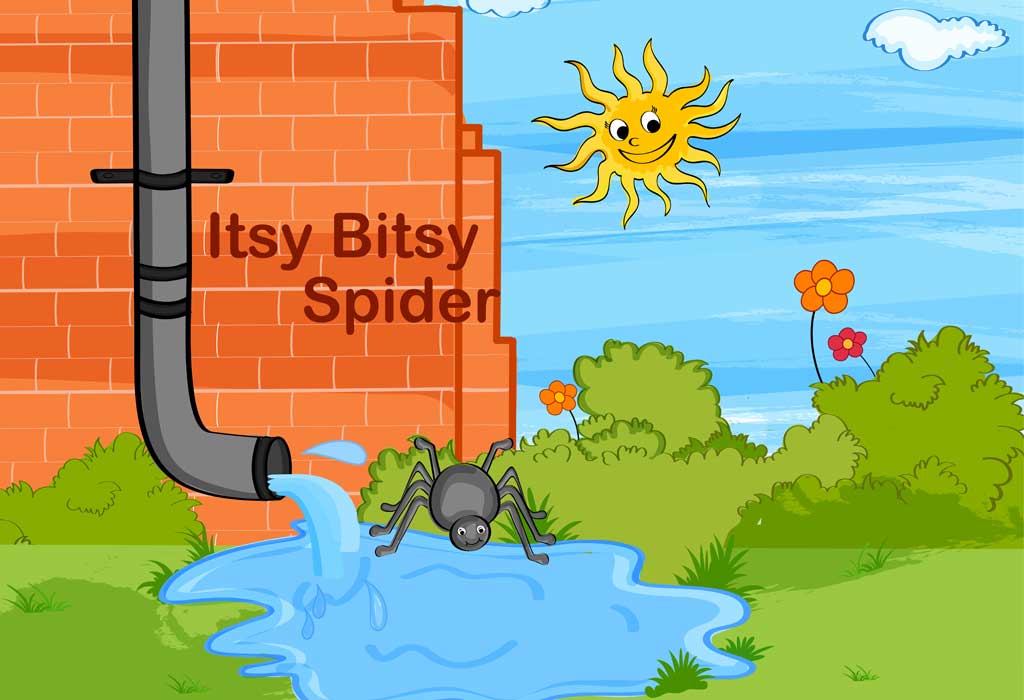
The itsy bitsy spider lyrics
The itsy bitsy spider climbed up the waterspout. Down came the rain and washed the spider out. Out came the sun and dried up all the rain, And the itsy bitsy spider climbed up the spout again.
Incy wincy spider climbed up the water spout. Down came the rain and washed poor Incy out. Out came the sunshine and dried up all the rain, So Incy wincy spider climbed up the spout again.
The eensy weensy spider climbed up the waterspout. Down came the rain and washed the spider out. Out came the sun and dried up all the rain, And the eensy weensy spider climbed up the spout again.
The eency weency spider climbed up the waterspout. Down came the rain and washed the spider out. Out came the sun and dried up all the rain, And the eency weency spider climbed up the spout again.
The itsy bitsy spider climbed up the little spout. Down came the rain and washed the spider out. Out came the sun and dried up all the rain, And the itsy bitsy spider climbed up the spout again.
The itsy bitsy spider climbed up the kitchen wall. Swoosh, went the fan and made the spider fall. Off went the fan, no longer did it blow, So the itsy bitsy spider back up the wall did go!
The itsy bitsy spider climbed up without a stop. She spun a silky web right at the very top. She wove and she spun and when her web was done, The itsy bitsy spider had a home to have some fun!
Meaning of the Poem
The “Diminutive Insect” sonnet is a basic youngsters’ rhyme that recounts a little bug’s excursion and its experiences with various climate components. While the sonnet is basically implied for small kids’ amusement, it likewise conveys a few topics and ideas that can be deciphered all the more extensively. The following are a couple of potential implications and subjects that can be related with the sonnet:
Diligence and Versatility: One of the focal messages of the sonnet is the insect’s assurance to conquer obstructions. Notwithstanding being washed somewhere around downpour, the bug doesn’t surrender and proceeds with its ascension. This should be visible as an illustration in tirelessness and versatility, instructing youngsters that difficulties are a characteristic piece of life, however they shouldn’t quit attempting.
Pattern of Life and Nature: The sonnet mirrors the repeating idea of life and the evolving seasons. The downpour and sun represent regular components that influence the insect’s excursion. This subject can be utilized to acquaint kids with the possibility that nature goes through cycles and changes, very much like the bug’s excursion all over the waterspout.
Straightforward Delights: The sonnet depicts the bug’s excursion as a basic experience. It features the delight of little accomplishments and the marvel of nature’s components. This can be a delicate suggestion to see the value in the easily overlooked details throughout everyday life and track down satisfaction in ordinary encounters.
Prologue to Ideas: The sonnet acquaints small kids with essential ideas like downpour, sun, climbing, and reiteration through its straightforward account. It’s a method for showing these ideas in a drawing in and noteworthy way.
Creative mind and Imagination: Kids frequently appreciate picturing the scenes depicted in the sonnet. This empowers their creative mind and imagination as they picture the bug’s trip, the downpour, and the sun to them.
Intelligent Learning: The hand motions that go with the tune make it intuitive and drawing in for kids. This sort of actual commitment can help with learning and memory maintenance.
About the Song
The “Very small Bug” is a notable nursery rhyme and kids’ melody that has been delighted in by ages of small kids. The tune’s straightforward and monotonous verses make it simple for kids to learn and chime in. The melody is frequently joined by hand signals that impersonate the activities of the bug and the climate components referenced in the verses.
The melody recounts the tale of a small insect that trips up a water ramble. Notwithstanding, the insect’s advancement is thwarted by downpour that washes it down. Regardless of this mishap, the sun emerges and evaporates the downpour, permitting the insect to continue its excursion up the spout.
The melody shows youngsters persistence, flexibility, and the repeating idea of life. It likewise acquaints essential ideas related with climate and nature. The different renditions of the melody, for example, “Incy Wincy Bug” and “Eensy Weensy Bug,” have slight varieties in the verses yet keep up with a similar generally speaking topic.
The “Very small Bug” is in many cases sung during circle time, in preschools, and at home with guardians and parental figures. It’s a perky and connecting way for kids to find out about musicality, rhyming words, and early language abilities. The hand developments that go with the melody likewise add a material and intelligent component that upgrades the general insight for youngsters.
Generally, the “Extremely small Bug” is a dearest part of youth music and is viewed as an exemplary in the domain of youngsters’ tunes and nursery rhymes.
Twinkle twinkle little star lyrics
The itsy bitsy spider song history
The historical backdrop of the “Diminutive Bug” tune can be followed back to the mid twentieth hundred years in the US. The beginnings of the tune are not conclusively reported, yet it is accepted to have created as a component of oral practice and was gone down through ages.
Here are a few central issues about the historical backdrop of the melody:
People Beginnings: In the same way as other nursery rhymes and kids’ tunes, the “Tiny Bug” logical began as a basic society melody that guardians, parental figures, and educators would sing to engage and teach small kids. These sorts of melodies were much of the time used to show kids fundamental ideas, like creatures, nature, and ordinary exercises.
Varieties: The tune has been known by various names, including “Incy Wincy Insect” and “Eensy Weensy Bug.” These varieties frequently have marginally various verses however share similar topic of a little bug’s undertakings.
Motions and Activities: One of the unmistakable highlights of the “Tiny Insect” is the going with hand signals that mirror the activities of the bug and the climate components. These motions make the tune intuitive and drawing in for kids.
Distribution: The melody was advocated through kids’ books, songbooks, and instructive materials. It turned into a staple in youth training because of its effortlessness, monotonous construction, and instructive worth.
Social Spread: Throughout the long term, the tune has spread across societies and dialects, adjusting to neighborhood dialects and customs. It has turned into a widespread youngsters’ melody, delighted in by kids all over the planet.
Instructive Worth: Past its diversion esteem, the melody assists small kids with creating significant abilities like language securing, musicality acknowledgment, and coordinated abilities through the hand developments.
Accounts and Transformations: The “Extremely small Bug” has been kept by various specialists and artists in different melodic styles. It has additionally been adjusted into energized recordings, manikin shows, and different types of youngsters’ media.
The wheels on the bus lyrics
The itsy bitsy spider Questions and Answers
Q: What is the poem “Itsy Bitsy Spider” about?
The poem is about a tiny spider’s adventure as it climbs up a waterspout and faces challenges from rain and the sun.
Q: What happens to the spider when the rain comes?
The rain washes the spider out of the waterspout.
Q: What does the sun do after the rain?
The sun comes out and dries up all the rain.
Q: Does the spider give up after being washed out by the rain?
No, the spider doesn’t give up. It climbs up the spout again after the rain stops.
Q: Why is the spider referred to as “itsy bitsy” or “incy wincy”?
These phrases are used to describe something very small. It adds a playful and cute quality to the spider’s character in the poem.
Q: What do the hand gestures in the song represent?
The hand gestures imitate the actions of the spider climbing, the rain falling, and the sun shining. They make the poem interactive and fun to sing.
Q: What lessons can we learn from the “Itsy Bitsy Spider”?
The poem teaches us about not giving up in the face of challenges, the cyclical nature of life, and finding joy in simple experiences.
Q: Can you create your own hand movements to go along with the song?
Absolutely! Creating your own hand movements can make the song even more personalized and enjoyable to sing.
Q: Why do you think the “Itsy Bitsy Spider” is such a popular children’s poem?
The poem’s simple and repetitive structure, along with its relatable story of facing obstacles and persevering, makes it easy for children to learn and remember. The hand gestures also add a physical and interactive element that children love.
The itsy bitsy spider lyrics The itsy bitsy spider lyrics The itsy bitsy spider lyrics The itsy bitsy spider lyrics The itsy bitsy spider lyrics The itsy bitsy spider lyrics The itsy bitsy spider lyrics The itsy bitsy spider lyrics The itsy bitsy spider lyrics The itsy bitsy spider lyrics The itsy bitsy spider lyrics The itsy bitsy spider lyrics The itsy bitsy spider lyrics The itsy bitsy spider lyrics The itsy bitsy spider lyrics The itsy bitsy spider lyrics



